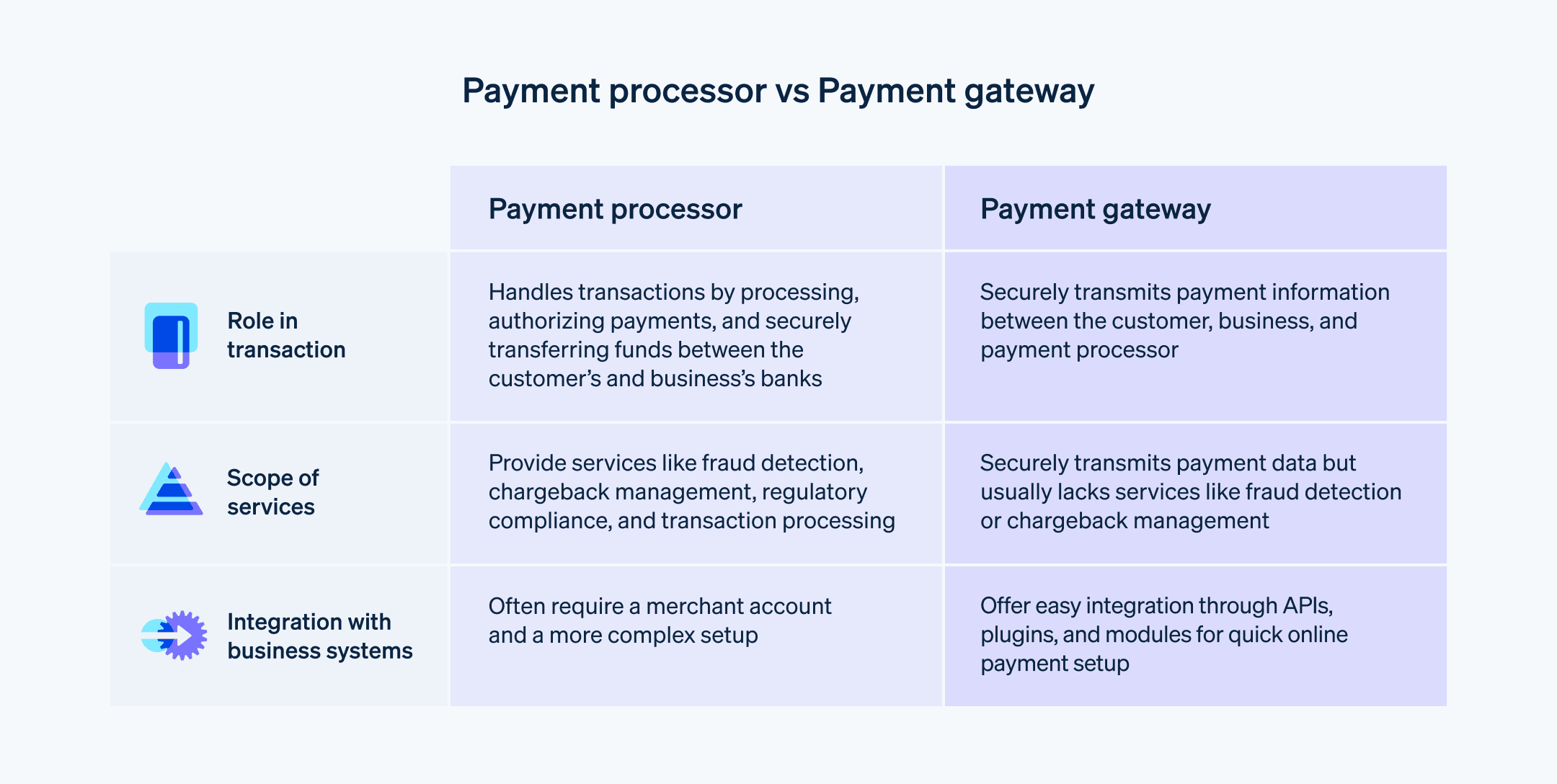为了让企业为其日益数字优先的客户提供简单而安全的交易,它们必须研究支付处理商和支付网关之间的区别和相互作用。
了解这些组件如何协同工作是提供顺畅可靠的支付体验的关键部分。下面,我们将介绍支付处理商和支付网关之间的主要区别、它们各自的角色、它们如何协同工作,以及 Stripe 如何以统一、全面的方式为平台和企业提供其功能。
目录
- 什么是支付处理商?
- 什么是支付网关?
- 支付处理商和支付网关之间有什么区别?
- 支付处理商和支付网关如何协同工作?
- Stripe 如何处理支付处理和支付网关
什么是支付处理商?
支付处理商是通过处理和授权信用卡、借记卡和其他数字支付方式为客户和企业之间的电子交易提供便利的公司或服务。支付处理商充当客户银行(发卡行,或发卡机构)和企业的银行(收单行,或收单机构)之间的中介,确保资金安全地从客户账户转移到商家账户。
支付处理商通过验证客户的付款信息、检查欺诈行为、确保遵守相关法规以及最终授权或拒绝交易,在电商和零售业中发挥着重要作用。通常,他们向企业收取服务费用,其中可能包括每笔交易的费用或交易金额的百分比。
什么是支付网关?
支付网关是一种在客户、企业和支付处理商之间安全地传输支付信息的技术或服务。它充当交易所涉各方之间的桥梁,能够交换处理付款所需的信息。支付网关相当于实体零售店中的销售点 (POS) 终端。
使用支付网关可确保敏感的支付信息得到安全处理,因为支付网关遵循严格的安全标准和加密协议,例如支付卡行业数据安全标准 (PCI DSS)。
支付处理商和支付网关之间有什么区别?
支付处理商和支付网关都是电子支付生态系统的重要组成部分,但它们具有不同的功能。以下是它们之间的主要区别:
交易过程中的角色
支付处理商:支付处理商负责通过处理和授权付款来协助完成交易,并确保客户银行和企业银行之间的资金安全转移。
支付网关 (Payment gateway):支付网关是连接组件,负责简化通信以及在客户、企业和支付处理商之间安全地传输支付信息。
服务范围
支付处理商:除了处理交易外,支付处理商还提供广泛的服务,包括欺诈检测、拒付管理和遵守支付法规。
支付网关 (Payment gateway):支付网关主要侧重于支付数据的安全传输,通常不提供欺诈检测或拒付管理等附加服务。
与业务系统集成
支付处理商:支付处理商通常要求企业建立商家账户来处理交易,并且可能涉及更复杂的设置程序。
支付网关 (Payment gateway):支付网关通常为企业提供更简单的集成选项,包括 API、插件和预构建模块,使企业能够快速开始接受线上付款。
一些公司同时提供支付处理和支付网关服务,作为集成解决方案的一部分。例如,Stripe 提供端到端支付服务,使企业更容易管理其线上交易。在下文中,我们将更详细地介绍 Stripe 如何处理支付功能的这些方面。

支付处理商和支付网关如何协同工作?
支付处理商和支付网关在协助企业和客户进行安全高效的电子交易方面发挥着不同但互补的作用。它们共同实现了各方之间的无摩擦通信和数据传输。
以下是支付处理商和支付网关在线上交易期间如何协作的分步概述:
客户发起交易
当客户准备进行购买时,他们会在商家的网站或应用上输入其信用卡信息(或其他支付信息)。支付网关的角色
支付网关安全地加密客户的支付数据,并将其发送到支付处理商。支付处理商的角色
支付处理商从支付网关接收加密的支付数据,并将其转发给客户的银行(发卡行)以请求交易授权。发卡行的响应
客户的银行会验证付款信息,检查可用资金,并根据其评估结果批准或拒绝交易。发卡行将此响应发送给支付处理商。处理商与网关的通信
支付处理商与支付网关共享银行的响应(批准或拒绝交易)。网关与企业的通信
支付网关将响应中继到企业的网站或应用,后者向客户显示相应的消息(交易获批或被拒)。资金结算
如果交易获得批准,支付处理商会协调将资金从客户的银行账户转移到企业的银行账户。这个过程称为结算,通常需要几个工作日才能完成。
在整个过程中,支付网关和支付处理商协同工作,安全高效地处理敏感的支付信息,同时遵守行业标准和加密协议,如 PCI DSS。
Stripe 如何处理支付处理和支付网关
Stripe 是一家一站式支付服务商,为企业和平台提供组合支付处理和支付网关功能。通过将这两个组件集成到一个简化的平台中,Stripe 让企业无需单独查找和获取这些服务。这种方法为企业带来了诸多好处,包括:
简化设置
借助 Stripe,企业可以快速设置并开始接受付款,而无需与支付网关和处理商建立单独的关系。这降低了开始线上交易的复杂性。无缝集成
Stripe 提供有据可查的 API、插件和预构建模块,使企业能够轻松地将 Stripe 的支付解决方案集成到其网站、应用和电商平台中。这使企业能够专注于其核心业务运营,而不是花时间处理支付处理的技术方面。增强安全性
Stripe 遵守最高安全标准(包括 PCI DSS 合规性),并使用先进的加密技术来保护敏感的支付数据。通过整合支付网关和处理商功能,Stripe 可确保整个交易流程的安全级别保持一致。统一的报告和管理
借助 Stripe 的集成解决方案,企业可以从单个管理平台 访问和管理所有交易数据、客户信息和支付分析。这简化了交易的跟踪和对账,使企业更容易监控其绩效并做出数据驱动的决策。降低成本
由于 Stripe 将支付网关和处理商服务集于一身,因此企业可以通过与单一提供商合作来节省费用。Stripe 提供透明且有竞争力的定价,与分别管理与网关和处理商的关系的费用相比,这对企业来说更具成本效益。可扩展性和灵活性
Stripe 支持多种支付方式 和货币,使企业能够轻松地在全球范围内扩展业务。该平台旨在随着企业的发展而扩容,并确保其支付基础设施能够处理增加的交易量和复杂性。持续改进
Stripe 平台受益于定期更新,包括新功能、增强功能和其他支付选项。这确保了使用 Stripe 的企业能够从容应对行业趋势,并为其客户提供最佳的支付体验。
如需详细了解如何使用 Stripe 进行支付处理并开始使用,请点击此处。
本文中的内容仅供一般信息和教育目的,不应被解释为法律或税务建议。Stripe 不保证或担保文章中信息的准确性、完整性、充分性或时效性。您应该寻求在您的司法管辖区获得执业许可的合格律师或会计师的建议,以就您的特定情况提供建议。